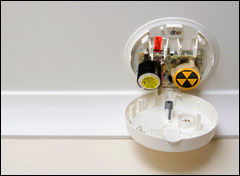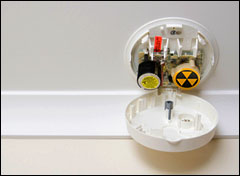Dear Umbra,
How should we safely dispose of old smoke detectors? Don’t they have small amounts of radioactive material in them? We tried bringing them to our town’s recycling center, which refused them, and the board of health would not take them at the hazmat pick-up day. It seems really wrong to toss them in the trash (our trash is incinerated). If you have any suggestions, I would appreciate it.
Laura S.
Natick, Mass.
Dearest Laura,
Thank you for this letter, for I have learned much from looking into the answer. E.g.: People! Laura is right. Smoke detectors contain radioactive material and should be disposed of as hazardous waste.

Your smoke detector’s contents might alarm you.
The detector’s manufacturer is required by law to properly dispose of the radioactive bits, so if your local hazmat folks refuse to deal, pop it in the mail. The manufacturer’s address should be on the detector itself or enclosed with the instructions/warranty. What if you are a normal person and disposed of the instructions/warranty? I read on the internets that most detectors are branded First Alert or American Sensors, so I say look ’em up and ship it on — you can find out more here.
Read on if you wish to learn more about the strange presence of radioactive material in this household appliance. The radioactive isotope is americium-241, a synthetic element related to plutonium production. Inside a smoke detector are two metal plates, one with a negative charge and the other a positive charge. The alpha particles emitted from the americium move about between the plates. They knock a few electrons off the oxygen and nitrogen in the air between the plates, creating positively charged atoms and free electrons. This results in an electrical current constantly going between the plates.
If a fire starts and the smoke reaches the detector, the smoke attaches itself to the charged ions and interrupts the electrical charge. This interruption triggers the incredibly annoying — but lifesaving — alarm. There are photosensitive smoke detectors that do not contain radioactive bits, but these apparently only excel with very smoldery fires, not flamey fires. Americium lasts a long time (see next paragraph), the alpha particles are easily blocked by the armature of the smoke detector, and this type of detector is quite sensitive to smoke — all of which are positive. Apparently the americium does the best job, and farther than that Umbra’s Science-O-Matic could not delve.
Americium-241 is not only in smoke detectors. It is a byproduct of nuclear weapons detonation, with a half-life of 432.7 years — well, I think the EPA’s strangely disturbing attempt to reassure the public should be inserted here. “Because americium-241 was widely dispersed globally during the testing of nuclear weapons, only very minute amounts of it are found in the soil, plants, and water.” We are estimated to be environmentally exposed to about one millirem per year of general radiation from nuclear testing. On the Nuclear Regulatory Commission’s Personal Radiation Dose Calculator, a smoke detector accounts for 0.008 mrem of exposure.
Smoke detectors do not threaten our health in our homes. The weak alpha rays disperse within a few inches of air or are blocked by other parts of the detector itself. Still: Do not dissect your smoke detector. Do not burn it. Do not eat it. And while technically you are allowed to throw it in the trash, according to the NRC, it would be far better if you sent it off with the hazmat folks or back to the manufacturer. We’d rather not have it in a landfill or incinerator. I mean, I wouldn’t. No matter how interesting it is to learn about americium-241.
Radionuclidely,
Umbra


